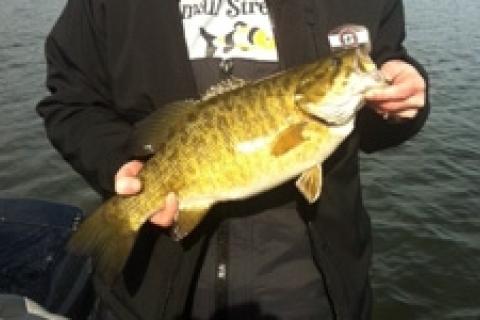
 Although any time of year is a good time to catch smallmouth bass the pre-spawn period is one of favorites for bass enthusiasts across the country. Fish in this period are aggressive, looking to feed and school up in predictable locations where anglers can target these fish.
Although any time of year is a good time to catch smallmouth bass the pre-spawn period is one of favorites for bass enthusiasts across the country. Fish in this period are aggressive, looking to feed and school up in predictable locations where anglers can target these fish.
Pre-spawn smallies start to make their move close to spawning sites in late spring. These fish look to settle into heavy structure areas adjacent to gravel shorelines or rubble. Smallmouths are especially fond of hiding in and around wood or large rocks in this pre-spawn period. The major feeding times will occur at dusk and at first light for anglers so being on the water when the fish are active is a must. The window for activity is a small one, and often there is no distinct pattern, but spending time in 6 to 10 feet of water with heavy structure near spawning sites should pay dividends. It might take a while to locate smallmouth, but once you find one, others will be nearby.
If you are fishing clear water conditions, sight fishing for these pre-spawn fish can be very productive. Knowledge of points and shoreline structure can be a benefit but quietly cruising the shallows with your trolling motor will allow you to spot smallmouth activity. If you find fish holding along the structure or bottom back your boat out slowly and cast to these fish from a distance.
Start fishing these bass with jigs and Kalin's grubs or wacky worms. The grubs and worms can be rigged weedless if snags are a problem. Make your cast and let the bait sink before starting your retrieve. Use a slow steady retrieve working the bait about a foot off the bottom. If that doesn't produce a strike, try walking the bait on the bottom with an occasional pause. These two presentations will allow you to catch both the active and lackadaisical fish.
Color is important with pre-spawn smallmouth. Neutral colors seem to produce better in clear water. Baits in browns and greens are the best place to start when rigging plastics but carry a few black grubs just in case the water is discolored. Experiment with colors since each lake may have its own preferred color.
When fishing grubs, the proper tackle is important. A 6- or 7-foot medium to medium-heavy action rod is perfect for fishing grubs and other soft plastics. A rod should have a sensitive tip but plenty of backbone to set the hook firmly. Longer, stiff rods can also be used for this type of fishing as they allow anglers to steer fish effectively out of thick cover. Line is another critical item for this type of fishing. Six- to 10-pound abrasion resistant lines are important as fish will hold tight to cover and try and tangle you up. If the water is clear try and use as light of line that you can without breaking fish off.
Pre-spawn smallmouth bass fishing can offer plenty of excitement to anglers in early spring. Not only are the fish easier to find this time of year, but they can be caught with many different baits. Get the boat on the water for a day and enjoy this special opportunity.
- 2951 views

